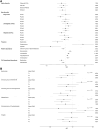The Oral Microbiome and All-Cause Mortality in a US Population-Representative Prospective Cohort
- PMID: 40513117
- PMCID: PMC12526875
- DOI: 10.1093/infdis/jiaf321
The Oral Microbiome and All-Cause Mortality in a US Population-Representative Prospective Cohort
Abstract
No large studies have evaluated whether the human oral microbiome is directly associated with mortality. We evaluated prospective associations between the oral microbiome, measured using 16S ribosomal RNA gene sequencing, from participants aged 20-69 years in the 2009-2012 cycles of the National Health and Nutrition Examination Survey (NHANES) and all-cause mortality (N = 7721, representing ∼194 million individuals). Alpha diversity was inversely associated with mortality, and some significant associations were observed with the beta diversity matrices. Higher relative abundances of Granulicatella and Lactobacillus were associated with increased risk, while Bacteroides was associated with decreased all-cause mortality at the genus level. Results suggest that oral bacterial communities may be important contributors to health and disease.
Keywords: NHANES; bacteria; human oral microbiome; mortality; population-representative sample.
Published by Oxford University Press on behalf of Infectious Diseases Society of America 2025.
Conflict of interest statement
Potential conflicts of interest. The authors: No reported conflicts of interest. All authors have submitted the ICMJE Form for Disclosure of Potential Conflicts of Interest. Conflicts that the editors consider relevant to the content of the manuscript have been disclosed.
Figures

References
-
- Socransky SS, Haffajee AD, Cugini MA, Smith C, Kent RL Jr. Microbial complexes in subgingival plaque. J Clin Periodontol 1998; 25:134–44. - PubMed
MeSH terms
Substances
Grants and funding
LinkOut - more resources
Full Text Sources

